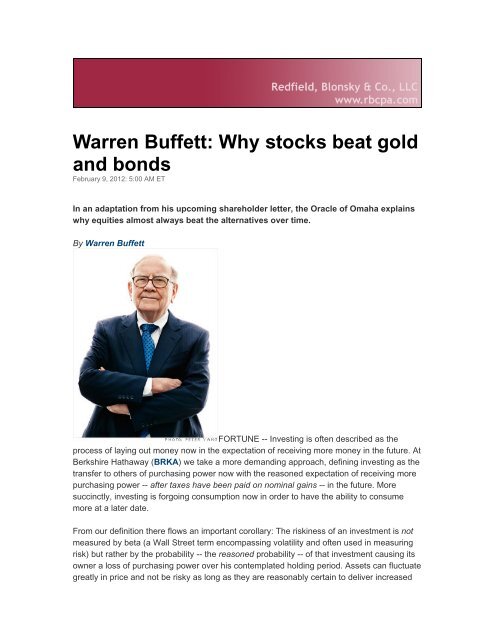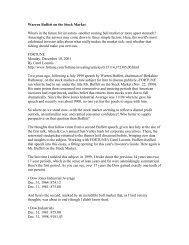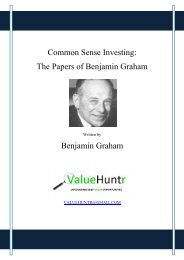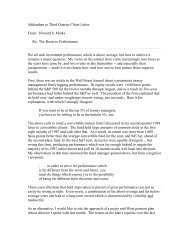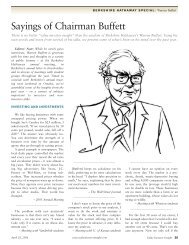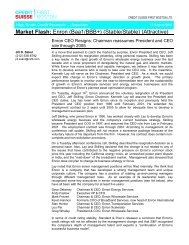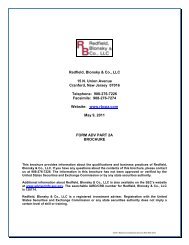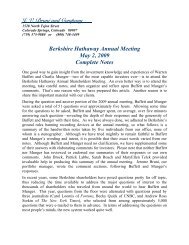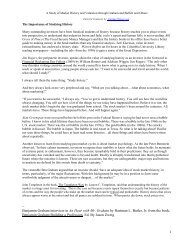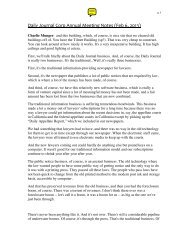Warren Buffett: Why stocks beat gold and bonds
Warren Buffett: Why stocks beat gold and bonds
Warren Buffett: Why stocks beat gold and bonds
Create successful ePaper yourself
Turn your PDF publications into a flip-book with our unique Google optimized e-Paper software.
<strong>Warren</strong> <strong>Buffett</strong>: <strong>Why</strong> <strong>stocks</strong> <strong>beat</strong> <strong>gold</strong><br />
<strong>and</strong> <strong>bonds</strong><br />
February 9, 2012: 5:00 AM ET<br />
In an adaptation from his upcoming shareholder letter, the Oracle of Omaha explains<br />
why equities almost always <strong>beat</strong> the alternatives over time.<br />
By <strong>Warren</strong> <strong>Buffett</strong><br />
FORTUNE -- Investing is often described as the<br />
process of laying out money now in the expectation of receiving more money in the future. At<br />
Berkshire Hathaway (BRKA) we take a more dem<strong>and</strong>ing approach, defining investing as the<br />
transfer to others of purchasing power now with the reasoned expectation of receiving more<br />
purchasing power -- after taxes have been paid on nominal gains -- in the future. More<br />
succinctly, investing is forgoing consumption now in order to have the ability to consume<br />
more at a later date.<br />
From our definition there flows an important corollary: The riskiness of an investment is not<br />
measured by beta (a Wall Street term encompassing volatility <strong>and</strong> often used in measuring<br />
risk) but rather by the probability -- the reasoned probability -- of that investment causing its<br />
owner a loss of purchasing power over his contemplated holding period. Assets can fluctuate<br />
greatly in price <strong>and</strong> not be risky as long as they are reasonably certain to deliver increased
purchasing power over their holding period. And as we will see, a nonfluctuating asset can<br />
be laden with risk.<br />
Investment possibilities are both many <strong>and</strong> varied. There are three major categories,<br />
however, <strong>and</strong> it's important to underst<strong>and</strong> the characteristics of each. So let's survey the<br />
field.<br />
Investments that are denominated in a given currency include money-market funds, <strong>bonds</strong>,<br />
mortgages, bank deposits, <strong>and</strong> other instruments. Most of these currency-based investments<br />
are thought of as "safe." In truth they are among the most dangerous of assets. Their beta<br />
may be zero, but their risk is huge.<br />
Over the past century these instruments have destroyed the purchasing power of investors<br />
in many countries, even as these holders continued to receive timely payments of interest<br />
<strong>and</strong> principal. This ugly result, moreover, will forever recur. Governments determine the<br />
ultimate value of money, <strong>and</strong> systemic forces will sometimes cause them to gravitate to<br />
policies that produce inflation. From time to time such policies spin out of control.<br />
Even in the U.S., where the wish for a stable currency is strong, the dollar has fallen a<br />
staggering 86% in value since 1965, when I took over management of Berkshire. It takes no<br />
less than $7 today to buy what $1 did at that time. Consequently, a tax-free institution would<br />
have needed 4.3% interest annually from bond investments over that period to simply<br />
maintain its purchasing power. Its managers would have been kidding themselves if they<br />
thought of any portion of that interest as "income."<br />
For taxpaying investors like you <strong>and</strong> me, the picture has been far worse. During the same<br />
47-year period, continuous rolling of U.S. Treasury bills produced 5.7% annually. That<br />
sounds satisfactory. But if an individual investor paid personal income taxes at a rate<br />
averaging 25%, this 5.7% return would have yielded nothing in the way of real income. This<br />
investor's visible income tax would have stripped him of 1.4 points of the stated yield, <strong>and</strong><br />
the invisible inflation tax would have devoured the remaining 4.3 points. It's noteworthy that<br />
the implicit inflation "tax" was more than triple the explicit income tax that our investor<br />
probably thought of as his main burden. "In God We Trust" may be imprinted on our<br />
currency, but the h<strong>and</strong> that activates our government's printing press has been all too<br />
human.
High interest rates, of course, can compensate purchasers for the inflation risk they face with<br />
currency-based investments -- <strong>and</strong> indeed, rates in the early 1980s did that job nicely.<br />
Current rates, however, do not come close to offsetting the purchasing-power risk that<br />
investors assume. Right now <strong>bonds</strong> should come with a warning label.<br />
Under today's conditions, therefore, I do not like currency-based investments. Even so,<br />
Berkshire holds significant amounts of them, primarily of the short-term variety. At Berkshire<br />
the need for ample liquidity occupies center stage <strong>and</strong> will never be slighted, however<br />
inadequate rates may be. Accommodating this need, we primarily hold U.S. Treasury bills,<br />
the only investment that can be counted on for liquidity under the most chaotic of economic<br />
conditions. Our working level for liquidity is $20 billion; $10 billion is our absolute minimum.<br />
Beyond the requirements that liquidity <strong>and</strong> regulators impose on us, we will purchase<br />
currency-related securities only if they offer the possibility of unusual gain -- either because a<br />
particular credit is mispriced, as can occur in periodic junk-bond debacles, or because rates<br />
rise to a level that offers the possibility of realizing substantial capital gains on high-grade<br />
<strong>bonds</strong> when rates fall. Though we've exploited both opportunities in the past -- <strong>and</strong> may do<br />
so again -- we are now 180 degrees removed from such prospects. Today, a wry comment<br />
that Wall Streeter Shelby Cullom Davis made long ago seems apt: "Bonds promoted as<br />
offering risk-free returns are now priced to deliver return-free risk."<br />
The second major category of investments involves assets that will never produce anything,<br />
but that are purchased in the buyer's hope that someone else -- who also knows that the<br />
assets will be forever unproductive -- will pay more for them in the future. Tulips, of all things,<br />
briefly became a favorite of such buyers in the 17th century.<br />
This type of investment requires an exp<strong>and</strong>ing pool of buyers, who, in turn, are enticed<br />
because they believe the buying pool will exp<strong>and</strong> still further. Owners are not inspired by<br />
what the asset itself can produce -- it will remain lifeless forever -- but rather by the belief that<br />
others will desire it even more avidly in the future.<br />
The major asset in this category is <strong>gold</strong>, currently a huge favorite of investors who fear<br />
almost all other assets, especially paper money (of whose value, as noted, they are right to<br />
be fearful). Gold, however, has two significant shortcomings, being neither of much use nor<br />
procreative. True, <strong>gold</strong> has some industrial <strong>and</strong> decorative utility, but the dem<strong>and</strong> for these
purposes is both limited <strong>and</strong> incapable of soaking up new production. Meanwhile, if you own<br />
one ounce of <strong>gold</strong> for an eternity, you will still own one ounce at its end.<br />
What motivates most <strong>gold</strong> purchasers is their belief that the ranks of the fearful will grow.<br />
During the past decade that belief has proved correct. Beyond that, the rising price has on its<br />
own generated additional buying enthusiasm, attracting purchasers who see the rise as<br />
validating an investment thesis. As "b<strong>and</strong>wagon" investors join any party, they create their<br />
own truth -- for a while.<br />
Over the past 15 years, both Internet <strong>stocks</strong> <strong>and</strong> houses have demonstrated the<br />
extraordinary excesses that can be created by combining an initially sensible thesis with<br />
well-publicized rising prices. In these bubbles, an army of originally skeptical investors<br />
succumbed to the "proof " delivered by the market, <strong>and</strong> the pool of buyers -- for a time --<br />
exp<strong>and</strong>ed sufficiently to keep the b<strong>and</strong>wagon rolling. But bubbles blown large enough<br />
inevitably pop. And then the old proverb is confirmed once again: "What the wise man does<br />
in the beginning, the fool does in the end."<br />
Today the world's <strong>gold</strong> stock is about 170,000 metric tons. If all of this <strong>gold</strong> were melded<br />
together, it would form a cube of about 68 feet per side. (Picture it fitting comfortably within a<br />
baseball infield.) At $1,750 per ounce -- <strong>gold</strong>'s price as I write this -- its value would be about<br />
$9.6 trillion. Call this cube pile A.<br />
Let's now create a pile B costing an equal amount. For that, we could buy all U.S. cropl<strong>and</strong><br />
(400 million acres with output of about $200 billion annually), plus 16 Exxon Mobils (the<br />
world's most profitable company, one earning more than $40 billion annually). After these<br />
purchases, we would have about $1 trillion left over for walking-around money (no sense<br />
feeling strapped after this buying binge). Can you imagine an investor with $9.6 trillion<br />
selecting pile A over pile B
Beyond the staggering valuation given the existing stock of <strong>gold</strong>, current prices make today's<br />
annual production of <strong>gold</strong> comm<strong>and</strong> about $160 billion. Buyers -- whether jewelry <strong>and</strong><br />
industrial users, frightened individuals, or speculators -- must continually absorb this<br />
additional supply to merely maintain an equilibrium at present prices.<br />
A century from now the 400 million acres of farml<strong>and</strong> will have produced staggering amounts<br />
of corn, wheat, cotton, <strong>and</strong> other crops -- <strong>and</strong> will continue to produce that valuable bounty,<br />
whatever the currency may be. Exxon Mobil (XOM) will probably have delivered trillions of<br />
dollars in dividends to its owners <strong>and</strong> will also hold assets worth many more trillions (<strong>and</strong>,<br />
remember, you get 16 Exxons). The 170,000 tons of <strong>gold</strong> will be unchanged in size <strong>and</strong> still<br />
incapable of producing anything. You can fondle the cube, but it will not respond.<br />
Admittedly, when people a century from now are fearful, it's likely many will still rush to<br />
<strong>gold</strong>. I'm confident, however, that the $9.6 trillion current valuation of pile A will compound<br />
over the century at a rate far inferior to that achieved by pile B.<br />
Our first two categories enjoy maximum popularity at peaks of fear: Terror over economic<br />
collapse drives individuals to currency-based assets, most particularly U.S. obligations, <strong>and</strong><br />
fear of currency collapse fosters movement to sterile assets such as <strong>gold</strong>. We heard "cash<br />
is king" in late 2008, just when cash should have been deployed rather than held. Similarly,<br />
we heard "cash is trash" in the early 1980s just when fixed-dollar investments were at their<br />
most attractive level in memory. On those occasions, investors who required a supportive<br />
crowd paid dearly for that comfort.<br />
My own preference -- <strong>and</strong> you knew this was coming -- is our third category: investment in<br />
productive assets, whether businesses, farms, or real estate. Ideally, these assets should<br />
have the ability in inflationary times to deliver output that will retain its purchasing-power<br />
value while requiring a minimum of new capital investment. Farms, real estate, <strong>and</strong> many<br />
businesses such as Coca-Cola (KO), IBM (IBM), <strong>and</strong> our own See's C<strong>and</strong>y meet that<br />
double-barreled test. Certain other companies -- think of our regulated utilities, for example --<br />
fail it because inflation places heavy capital requirements on them. To earn more, their<br />
owners must invest more. Even so, these investments will remain superior to nonproductive<br />
or currency-based assets.
Whether the currency a century from now is based on <strong>gold</strong>, seashells, shark teeth, or a piece<br />
of paper (as today), people will be willing to exchange a couple of minutes of their daily labor<br />
for a Coca-Cola or some See's peanut brittle. In the future the U.S. population will move<br />
more goods, consume more food, <strong>and</strong> require more living space than it does now. People<br />
will forever exchange what they produce for what others produce.<br />
Our country's businesses will continue to efficiently deliver goods <strong>and</strong> services wanted by<br />
our citizens. Metaphorically, these commercial "cows" will live for centuries <strong>and</strong> give ever<br />
greater quantities of "milk" to boot. Their value will be determined not by the medium of<br />
exchange but rather by their capacity to deliver milk. Proceeds from the sale of the milk will<br />
compound for the owners of the cows, just as they did during the 20th century when the Dow<br />
increased from 66 to 11,497 (<strong>and</strong> paid loads of dividends as well).<br />
Berkshire's goal will be to increase its ownership of first-class businesses. Our first choice<br />
will be to own them in their entirety -- but we will also be owners by way of holding sizable<br />
amounts of marketable <strong>stocks</strong>. I believe that over any extended period of time this category<br />
of investing will prove to be the runaway winner among the three we've examined. More<br />
important, it will be by farthe safest.<br />
This article is from the February 27, 2012 issue of Fortune.<br />
http://finance.fortune.cnn.com/2012/02/09/warren-buffett-berkshire-shareholderletter/section=money_topstories&utm_source=feedburner&utm_medium=feed&utm_campai<br />
gn=Feed%3A+rss%2Fmoney_topstories+%28Top+Stories%29


